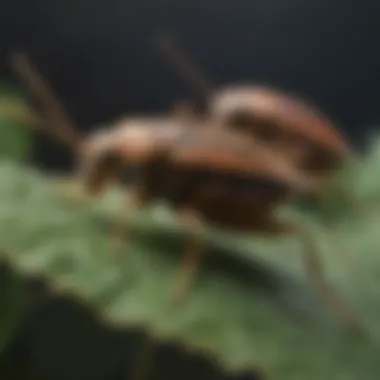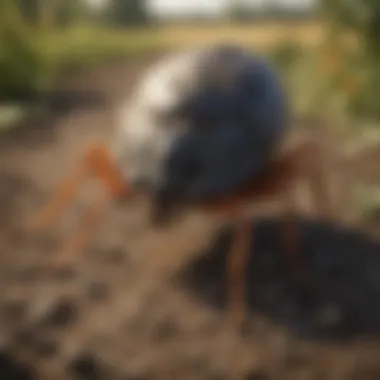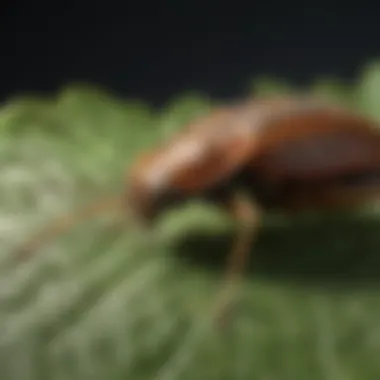Effective Strategies for Killing Squash Bugs


Intro
Squash bugs can devastate crops quickly. Their presence often signals a larger issue in agricultural pest management. Farmers and gardeners face significant challenges in keeping these pests at bay. Understanding their biology and behaviors is crucial. Effective strategies ensure healthier plants and contribute to sustainable farming practices. This article explores these strategies comprehensively.
Latest Trends in Agriculture
Overview of Current Trends
Agriculture is evolving rapidly. Modern techniques focus on sustainability while maximizing yields. Farmers are increasingly turning to integrated pest management (IPM). This method blends various strategies for effective pest control. Crops suffer from fewer pesticides with this approach, which also benefits the environment. Moreover, the adoption of organic practices is on the rise. More consumers demand food produced without harmful chemicals. This shift encourages farmers to adapt and innovate.
Impact of Technology on Farming Practices
Technology plays a vital role in modern agriculture. Precision agriculture allows for targeted treatments of crops. Drones equipped with cameras assess crop health and pinpoint pest locations. This technology simplifies the identification of squash bugs, leading to timely action. Additionally, data analytics helps farmers predict pest outbreaks. These advancements support sustainable practices and reduce reliance on harmful chemicals.
Sustainable Practices: Towards a Greener Future
Importance of Sustainability in Agriculture
Sustainability in agriculture ensures long-term viability. It minimizes environmental impact and supports biodiversity. Focusing on sustainable practices enhances soil health. In turn, this results in stronger crops less susceptible to pests. Farmers must invest in maintaining ecosystems to combat pests like squash bugs effectively.
Methods for Sustainable Farming
Implementing sustainable techniques requires commitment. Some effective methods include:
- Crop rotation: This technique disrupts squash bug life cycles. Changing crops regularly reduces their populations.
- Cover cropping: Planting cover crops during off-seasons improves soil health while protecting it from erosion. It can also deter pests.
- Companion planting: Certain plants repel squash bugs. For instance, planting marigolds alongside squash may help deter these pests.
These methods have proved beneficial for many farmers.
Gardening Techniques and Tips
Essential Gardening Tools and Equipment
Proper tools are critical for effective pest management. Gardeners should invest in:
- Handheld sprayers: Useful for applying natural solutions against squash bugs.
- Insect nets: These protect crops while allowing sunlight and rain to nourish.
- Row covers: Effective for shielding seedlings from pests early in the season.
Using the right equipment enhances the gardener's ability to respond to pests decisively.
Seasonal Gardening Practices
Understanding seasonal cycles assists in better pest management.
- Spring: Monitor plants closely for early signs of squash bugs. Early prevention is vital for control.
- Summer: Implement integrated pest management techniques. This phase is critical for crop protection.
- Fall: Clean up and destroy plant debris. Squash bugs often overwinter in leftover plant material.
By adapting to seasonal changes, gardeners can effectively manage squash bug populations throughout the growing season.
Understanding Squash Bugs
Understanding squash bugs is essential not merely for pest removal but also for effective agricultural practices. This comprehension aids farmers and gardeners in devising strategies to protect their crops from significant damage. Knowledge of squash bugs' biology, life cycle, and identification helps determine the best management strategies. Moreover, this understanding fosters sustainable practices. It allows for the reduction of chemical interventions, thereby minimizing environmental impact. The more we know, the more equipped we become to tackle the issues related to these pests.
Biology of Squash Bugs
Squash bugs, scientifically known as Anasa tristis, are true bugs belonging to the family Corixidae. Native to North America, these intelligent insects thrive in warm climates. Adult squash bugs can grow to around three-quarters of an inch long, appearing mostly dark brown or black. They possess long legs and a flat back which helps them blend into their surroundings. Their mouthparts are specially adapted to pierce plant tissues, allowing them to extract sap. This feeding behavior results in significant harm to plants, leading to stunted growth.
Life Cycle Stages
The life cycle of squash bugs consists of three main stages: egg, nymph, and adult. During spring, female squash bugs lay clusters of approximately 15 to 20 yellow or green eggs on the undersides of leaves. These eggs hatch in about a week under favorable conditions. The newly emerged nymphs are small and green, resembling miniature adults. They will undergo several molts, growing larger and darker with each stage, before reaching adulthood roughly within six to eight weeks. Understanding these stages aids in pinpointing the right time for interventions.
Identification and Characteristics


Identifying squash bugs is straightforward if one knows what to look for. The adults are roughly 0.75 inches long, with a flat body and a distinctive angular shape. They have long antennae and are often seen resting on squash plants, especially under leaves. Nymphs, on the other hand, are smaller and less distinguishable at first glance. Their color changes from green to a darker brown as they mature.
Besides physical characteristics, squash bugs leave tell-tale signs of damage, which aids in identification. Dark spots on leaves, wilting plants, and overall decline in crop health can suggest a squash bug infestation. Regular monitoring and understanding these signs support quicker management responses, making it vital for effective control measures.
Impact of Squash Bugs on Agriculture
The impact of squash bugs on agriculture is a crucial element of pest management strategies. Understanding the ways in which these pests affect agricultural productivity can help farmers and gardeners develop effective control methods. Squash bugs, particularly the species Anasa tristis, are notorious for their sap-sucking behavior, which damages plants and can lead to significant yields decline. When not controlled, squash bug infestations can devastate entire crops, especially among squash and pumpkin varieties.
In this context, it is important to analyze both the physical damage inflicted on crops and the broader economic implications for farmers and the agricultural market. Recognizing the signs of infestation early allows for more manageable and cost-effective interventions. The following sections provide a detailed examination of the crop damage caused by squash bugs and the resultant economic consequences.
Crop Damage Examination
Squash bugs cause damage primarily by feeding on the sap of plants, leading to wilting and nutrient deficiency. When they pierce the plant's vascular system, they not only consume vital nutrients but also introduce bacteria that can result in additional diseases. Symptoms of damage include:
- Yellowing of leaves
- Stunted plant growth
- Premature wilting or leaf drop
- Formation of black, necrotic areas on the leaves
In severe infestations, the entire plant may collapse, making it nearly impossible to harvest. During critical growth phases, such as flowering or fruit development, the presence of squash bugs can essentially reduce the quality and quantity of the final yield. This damage not only affects the immediate crop but can have longer-term implications for soil health and future planting success.
Economic Consequences
The economic consequences of squash bug infestations extend beyond direct crop loss. Farmers may face increased costs due to:
- Purchase of insecticides and other control measures
- Labor costs associated with monitoring and applying treatments
- Lower market prices for damaged or diseased crops
The financial impact can be significant, especially for small-scale farmers who may rely heavily on their squash crop for income. Studies indicate that losses due to squash bug infestations can reach up to 50% of total harvest in areas where these pests are prevalent.
Moreover, the presence of squash bugs can influence local supply chains, impacting pricing and availability for consumers. Higher incidences of infestation can lead to reduced supply in local markets, causing a fluctuation in prices that affects both farmers and consumers.
Proper monitoring and management practices are essential to cope with the economic impacts of squash bugs. Integrated Pest Management (IPM) can lead to better long-term solutions.
Preventive Measures
Preventive measures are critical in managing squash bugs effectively. By implementing strategies that limit the likelihood of an infestation, farmers and gardeners can mitigate the damage caused by these pests. A proactive approach helps in saving resources, ensuring crop health, and ultimately improving yield. Different prevention techniques are undoubtedly valuable in understanding squash bug behavior and lifecycle.
Crop Rotation Techniques
Crop rotation is highly effective in disrupting the life cycle of squash bugs. By alternating the types of crops planted in a specific area from season to season, it reduces the continuity of food supply for the squash bugs. For instance, following a planting of squash with crops that these pests do not prefer can minimize their presence.
This technique not only confuses the insects but also promotes soil health. Rotating crops can enhance nutrient availability and limit pest build-up in the soil. It’s worthwhile to keep in mind that planning your crop rotation involves knowing which crops belong to the same family.
Proper Plant Spacing
Maintaining proper plant spacing is vital in preventing squash bug infestations. When plants are crowded, they create a humid microclimate that is favorable for pests. By adhering to recommended spacing guidelines, air circulation improves, making the environment less inviting for squash bugs.
The optimal spacing allows plants to establish strong root systems and reduces competition for nutrients. It also limits the ease with which squash bugs can migrate between plants, decreasing the chance of a widespread infestation. Careful planning regarding spacing is relatively simple yet effective.
Using Row Covers
Using row covers offers an extra layer of protection for squash crops. These lightweight fabrics shield plants from insect pests while still allowing light, air, and moisture to reach the plants. Such covers can be placed over young plants after planting and removed when the plants flower. The barrier provided by these covers is significant. It prevents adult squash bugs from laying eggs on the foliage, thereby reducing potential future generations.
It's important to ensure that the row covers are secured properly to prevent pests from entering underneath. Also, monitoring is necessary when using these covers. Growers should check for any moisture build-up or overheating under the fabric, which could harm the plants. Using these simple and effective preventative measures can significantly contribute to maintaining healthier crops.
Natural Control Methods
Natural control methods play a significant role in managing squash bugs, offering a sustainable approach that supports the health of ecosystems. These methods focus on using natural predators, homemade solutions, and compatible planting strategies to minimize squash bug populations. Implementing these strategies can lead to a balanced garden or farm environment while reducing the reliance on synthetic chemicals.
Beneficial Insects
Utilizing beneficial insects can effectively control squash bug populations. Predatory insects, such as ladybugs and lacewings, feed on squash bug eggs and nymphs, thereby reducing the chances of infestation. Additionally, parasitic wasps target squash bug eggs, ensuring that fewer bugs reach adulthood.


To attract these beneficial insects, it is advisable to plant nectar-rich flowers nearby. Some effective plants include dill, yarrow, and marigolds. They not only enhance the ecosystem but also help in controlling pests. Introducing these allies into the garden can create a natural balance, allowing crops to flourish.
Homemade Remedies
Homemade remedies can provide an eco-friendly solution for squash bug problems. Simple mixtures can deter squash bugs without harming beneficial insects.
- Soap and Water Spray: Combine mild dish soap with water in a spray bottle. Spraying this mixture directly on the bugs can suffocate them. Be sure to test on a small leaf area first, as some plants may react poorly.
- Garlic Spray: Blend garlic cloves with water and let it steep overnight. Strain the liquid and spray it on affected plants. The strong odor is unpleasant for squash bugs and acts as a repellant.
- Neem Oil: Derived from the neem tree, neem oil disrupts the life cycle of many insects. Mixing neem oil with water and applying it to plants can provide a protective barrier against squash bugs.
Companion Planting
Companion planting is another effective strategy to keep squash bugs at bay. Certain plants can naturally deter squash bugs while promoting the growth of squash. For instance, planting basil near squash can repel various insect pests.
Some other beneficial companion plants include:
- Nasturtiums: These flowers attract aphids away from squash plants, diverting squash bugs.
- Radishes: They can deter squash bugs due to their pungent nature.
- Marigolds: Often used for pest control, they can repel numerous harmful insects, including squash bugs.
Companion planting maximizes garden space while naturally controlling pests. It is a low-impact measure that fits well in sustainable agriculture practices.
In summary, natural control methods provide various options for managing squash bug infestations. Engaging beneficial insects, employing homemade remedies, and mastering companion planting can help maintain crop health and reduce damage without resorting to harsh chemicals.
Chemical Control Approaches
Chemical control methods play a significant role in managing squash bug populations effectively. When natural methods either fail or are insufficient, insecticides can provide a potent alternative worth considering. These products, designed to specifically target pests, can mitigate crop damage when used correctly. However, it is essential for farmers and gardeners to weigh the benefits against potential drawbacks, such as harm to beneficial insects and the environment. A balanced approach, utilizing chemicals alongside other strategies, often yields the best results.
Types of Insecticides
Insecticides are classified into several categories based on their active ingredients and modes of action. Understanding these classifications helps in selecting the appropriate treatment for squash bugs. Some common types include:
- Contact Insecticides: These kill pests on direct contact. Examples include permethrin and bifenthrin. They can be effective but may require thorough application to ensure coverage.
- Systemic Insecticides: Taken up by plants, these insecticides work from within. For example, imidacloprid can affect squash bugs once they feed on the treated plant.
- Biopesticides: Derived from natural materials, such as bacteria or plant extracts, these methods are generally less harmful to non-target organisms. An example is insecticidal soap.
Application Techniques
Proper application techniques are crucial for maximizing the effectiveness of insecticides. Here are some recommended practices:
- Timing: Apply insecticides in the early morning or late evening when squash bugs are less active, increasing the chances of effective treatment.
- Targeting: Aim applications directly at the base of plants where squash bugs typically reside. This ensures higher contact rates.
- Spraying Techniques: Use a sprayer that provides a fine mist. This allows for better coverage and penetration into the foliage.
It is also important to read and follow the product labels carefully, as they provide specific instructions for effective application.
Safety and Environmental Concerns
While chemical controls can be effective, they come with safety and environmental considerations. Farmers and gardeners must prioritize safety to protect themselves, beneficial organisms, and the ecosystem.
"The need for safety and environmental stewardship is paramount when using chemical controls."
Some key points include:
- Personal Protective Equipment (PPE): Always wear gloves, masks, and protective clothing when handling or applying insecticides.
- Impact on Non-target Species: Harmful effects can occur not just to squash bugs, but also beneficial insects like bees and natural predators of pests. Using targeted insecticides can help minimize this impact.
- Soil and Water Impacts: Runoff from treated areas can contaminate local waterways. It is crucial to apply chemicals during dry weather and away from water sources.
Balancing chemical pest control with integrated practices can lead to more sustainable gardening and farming methodologies, ultimately supporting healthier ecosystems.
Integrated Pest Management (IPM)
Integrated Pest Management, often abbreviated as IPM, represents a holistic approach to controlling pests, including the squash bug. It emphasizes the integration of multiple strategies rather than relying solely on one method. This approach is crucial for maintaining a balance in ecosystems while effectively managing pests, thus reducing reliance on chemical treatments.
The key elements that constitute IPM include biological control, cultural practices, physical control measures, and chemical control when needed. It encourages the use of naturally occurring enemies of pests, such as beneficial insects, while also recommending the use of resistant plant varieties. These methods create an environment less conducive to pest establishment and proliferation.
Some benefits of IPM include:
- Reduced Chemical Use: By relying on natural methods and maintaining pest populations below damaging levels, the need for pesticides diminishes.
- Sustainability: IPM promotes long-term solutions. This contributes to healthier soil and plants, resulting in better crop yields.
- Safety: A reduced chemical footprint ensures a safer environment for humans, animals, and beneficial organisms alike.


Considerations for effective IPM implementation must include understanding pest biology and behavior, careful monitoring of pest populations, and timely actions based on thresholds that indicate when management is necessary. Therefore, it is essential for farmers and gardeners to stay informed about local pest issues and engage in continuous learning about their practices.
"Successful IPM programs integrate multiple strategies tailored to the local environment and pest ecology."
Principles of IPM
The principles of IPM revolve around preventing pest issues before they arise and managing populations through informed decision-making. Here are core tenets:
- Monitoring and Identification: Regularly observe fields for signs of squash bugs or other pests to identify when and where they appear.
- Threshold Levels: Establish economic thresholds based on research; understand the point at which pest populations necessitate intervention.
- Cultural Practices: Adjust practices related to planting, irrigation, and fertilization to discourage pests.
- Biological Controls: Promote beneficial species such as predatory insects or parasitic wasps that naturally suppress pest populations.
- Chemical Controls: If necessary, apply pesticides judiciously, opting for less-toxic options and targeting specific pest life stages to minimize impact on non-target species.
Implementing IPM for Squash Bugs
To effectively implement IPM specifically for squash bugs, farmers should combine various strategies and modify their practices based on pest dynamics. Steps may include:
- Field Monitoring: Use traps, inspection, and observation techniques to monitor squash bug populations closely. This could involve placing yellow sticky traps in fields.
- Cultural Modifications: Alter planting schedules or rotate crops to disrupt squash bug life cycles. This might mean planting squash later in the growing season to evade early infestations.
- Use of Barriers: Employ physical barriers like row covers to prevent squash bugs from accessing plants at vulnerable stages.
- Encouraging Natural Predators: Introduce or protect beneficial insects that prey on squash bugs. For example, attracting ladybugs and spiders can help keep pest numbers down.
- Education and Training: Keep abreast of the latest IPM practices and research on pest management tailored to squash bugs. Online resources, agricultural extension services, and local farming groups can provide valuable information.
This comprehensive view into IPM presents an effective framework for dealing with squash bugs while maintaining environmental health. It underscores the necessity for informed practices that balance productivity with sustainability.
Monitoring and Assessing Squash Bug Populations
Monitoring squash bug populations is an essential aspect of effective pest management. Understanding the dynamics of their presence helps in determining when to take action, minimizing crop damage. This process involves regular observation, identification of squash bugs, and assessing their numbers. Accurate monitoring can inform decisions, ensuring that interventions are applied at the most effective timing.
Trap Methods
One of the most effective ways to monitor squash bug populations is through trapping. Using traps can help not only in counting the insects but also in understanding their population density in a specific area.
Types of traps to consider include:
- Yellow sticky traps: These traps attract squash bugs due to their color. The sticky surface captures them, making it easy to calculate their numbers.
- Pheromone traps: These traps use chemical lures to attract squash bugs. They are particularly effective during specific times of the season when the bugs are most active.
- Handheld vacuum traps: By using a handheld vacuum, growers can capture squash bugs directly from plants. This method allows for immediate identification and counting.
Setting traps in various zones of the garden or field can provide a comprehensive understanding of squash bug activity. Regularly checking these traps is crucial. This frequency in monitoring enables timely responses to infestations, potentially preventing more extensive crop damage.
Regular Monitoring Techniques
In addition to trapping, employing regular monitoring techniques can significantly enhance the understanding of squash bug populations. These techniques ensure a proactive approach to pest management.
Key methods include:
- Visual inspections: Routinely inspect plants for signs of squash bugs. Look under leaves and around stems where they often hide.
- Egg counting: Squash bugs lay their eggs in clusters. Monitoring for these eggs can alert farmers to potential outbreaks before they happen.
- Damage assessment: Observing the symptoms of squash bug damage can also indicate the presence of these pests. Wilting leaves and yellow patches are common signs.
Regular monitoring should occur at least once a week, especially during peak growing season. Record observations in a logbook to track patterns over time. This documentation can be valuable for future planning and decision-making.
"Effective monitoring allows for timely interventions. It transforms pest control from reactive to proactive, ultimately saving crops and reducing costs."
Engaging in comprehensive monitoring and assessment techniques not only helps in managing squash bugs but also fosters a healthier agricultural ecosystem.
End and Best Practices
The final segment of this article emphasizes the critical nature of concluding and formulating best practices regarding squash bug management. By synthesizing a variety of strategies—ranging from preventive measures to integrated pest management—farmers and gardeners can position themselves effectively against these pests. This segment serves as a summation of essential themes, providing a clear framework for action.
Best practices regarding squash bug control encompass various dimensions, including operational efficiency, economic prudence, and ecological responsibility. Properly executed strategies can minimize crop loss while supporting sustainable agricultural techniques. Thus, the integration of diverse management strategies acts not only to combat squash bug infestations but also to mitigate their broader impact on the environment.
Summary of Effective Strategies
To ensure robust squash bug management, the following effective strategies stand prominent:
- Preventive Measures: Implementing crop rotation, proper plant spacing, and utilizing row covers can significantly reduce the likelihood of infestations.
- Natural Control Methods: Encouraging beneficial insects and employing homemade remedies can offer a sustainable alternative to chemical measures.
- Chemical Control Approaches: When necessary, the judicious application of insecticides can be effective. However, it is crucial to adhere to safety guidelines to mitigate risks to beneficial insects and the environment.
- Integrated Pest Management (IPM): Adopting IPM principles helps to harmonize various control methods, ensuring a comprehensive approach to pest management throughout the growing season.
This compilation of strategies allows farmers and enthusiasts to craft tailored solutions whether they are managing small gardens or extensive agricultural plots.
Future Research Directions
As the field of pest management evolves, future research directions should focus on several key areas:
- Development of Resistant Crop Varieties: Research into squash cultivars with inherent resistance to squash bugs can provide farmers with viable long-term solutions.
- Enhancing Biocontrol Methods: Exploring the role of additional beneficial insects and natural predators could enhance the biological control spectrum available.
- Impact of Climate Change: Studying how changing environmental conditions affect squash bug behavior and life cycles will be crucial for adaptive management strategies.
- Technological Innovations: The integration of technologies like drones for monitoring and precise application of treatments can revolutionize pest management practices.
By prioritizing these critical areas, researchers can contribute to more effective, sustainable methods for dealing with squash pests, supporting both agricultural productivity and environmental stewardship.







